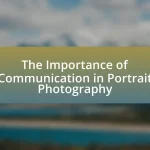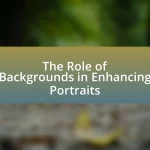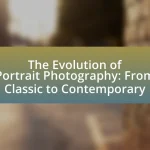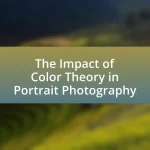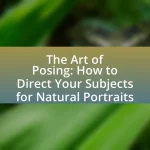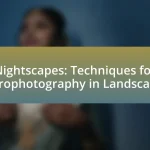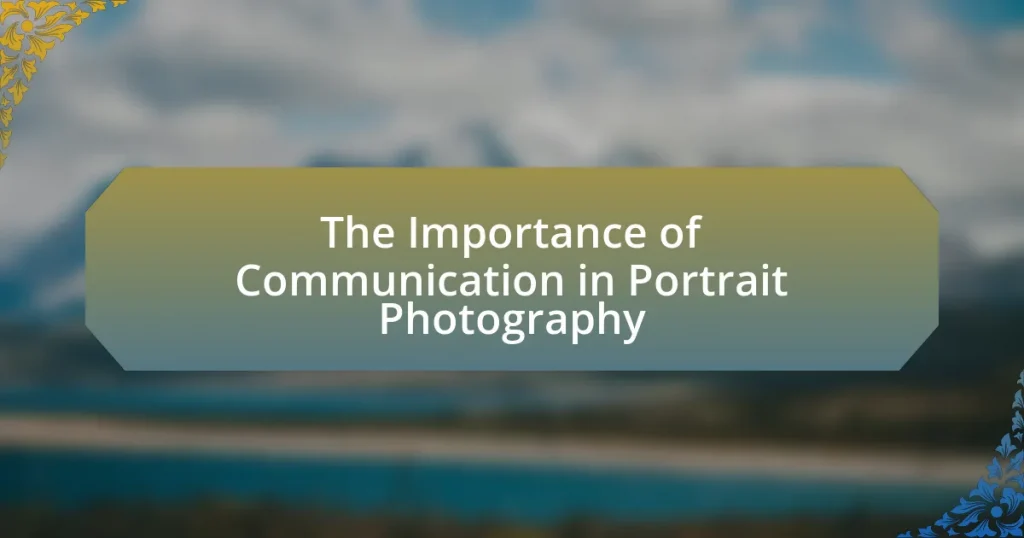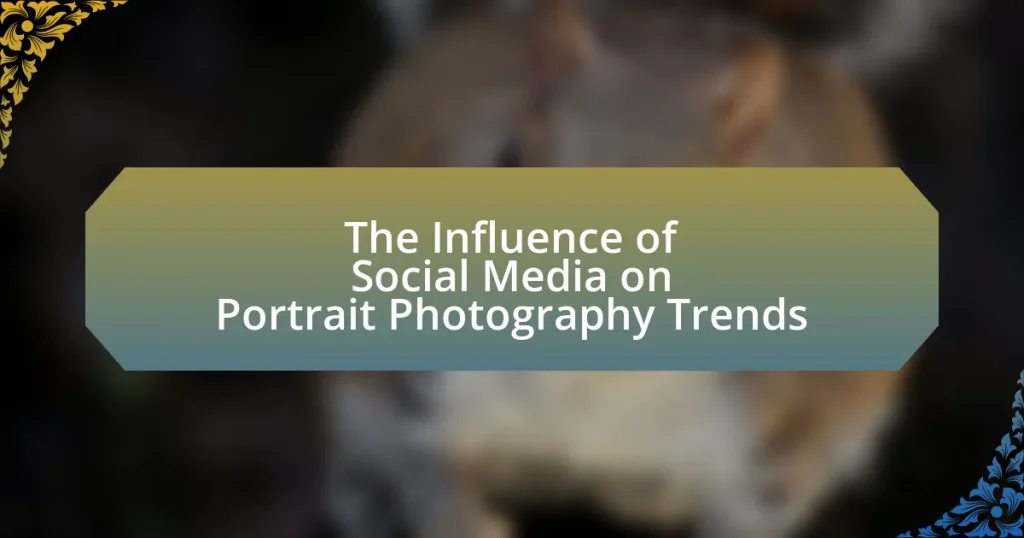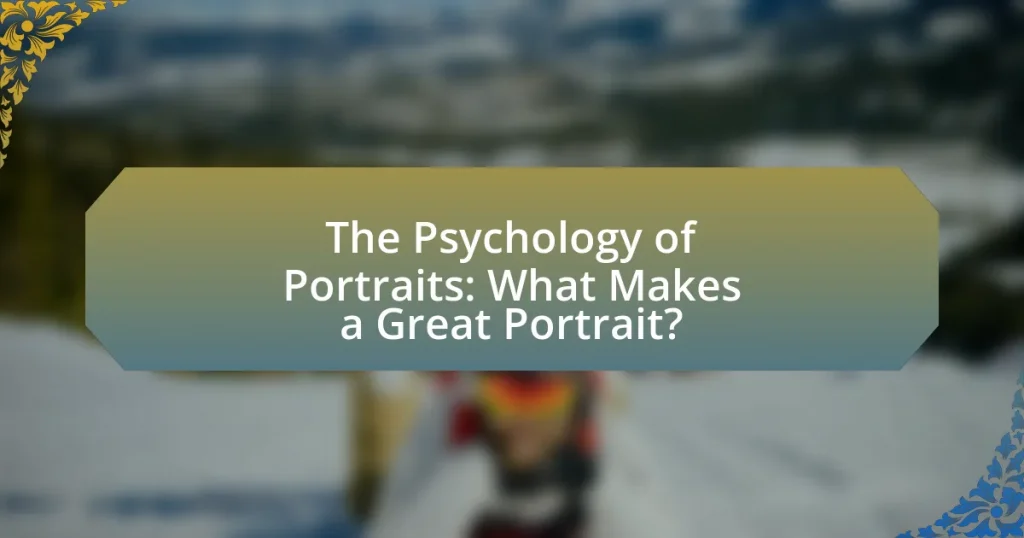The article focuses on the art of long exposure in landscape photography, a technique that captures images with extended exposure times to blend motion and light, creating ethereal effects. It discusses the differences between long exposure and standard photography, emphasizing the importance of slow shutter speeds, camera stabilization, and light control through neutral density filters. Key principles, equipment, and techniques for mastering long exposure photography are outlined, including the impact of shutter speed, the role of lenses, and best practices for composition. Additionally, the article addresses common challenges faced by photographers and offers practical tips for improving long exposure results.
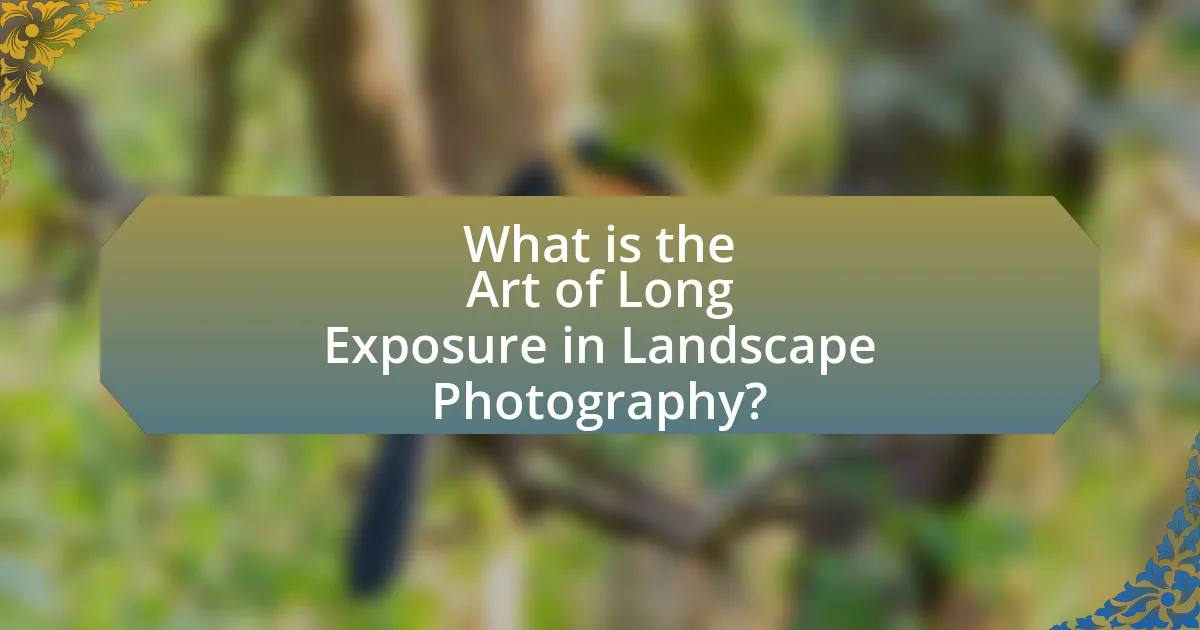
What is the Art of Long Exposure in Landscape Photography?
The Art of Long Exposure in Landscape Photography involves capturing images with extended exposure times, allowing for the blending of motion and light to create ethereal effects. This technique enables photographers to depict elements such as flowing water, moving clouds, and light trails in a way that conveys a sense of time and movement, enhancing the visual narrative of the landscape. Long exposure photography typically requires the use of a tripod to stabilize the camera and neutral density filters to reduce light entering the lens, thus allowing for longer shutter speeds without overexposing the image. This method has been widely adopted since the advent of photography in the 19th century, with notable examples seen in the works of photographers like Ansel Adams, who utilized long exposure to capture the dramatic contrasts and textures of natural landscapes.
How does long exposure technique differ from standard photography?
Long exposure technique differs from standard photography primarily in the duration of the camera’s shutter being open. In long exposure photography, the shutter remains open for extended periods, ranging from several seconds to minutes or even hours, allowing more light to enter and capturing motion over time, such as flowing water or moving clouds. This contrasts with standard photography, where the shutter speed is typically much faster, freezing motion and capturing a single moment in time. The result of long exposure is often a smooth, ethereal effect in the image, which is not achievable with standard photography methods.
What are the fundamental principles of long exposure photography?
The fundamental principles of long exposure photography include using a slow shutter speed, controlling light intake, and stabilizing the camera. A slow shutter speed, typically longer than one second, allows for the capture of motion over time, resulting in effects like smooth water or blurred clouds. Controlling light intake is essential, often achieved with neutral density filters, which reduce the amount of light entering the lens without affecting color. Stabilizing the camera, usually with a tripod, prevents unwanted movement and ensures sharp images during extended exposure times. These principles are crucial for achieving the desired artistic effects in landscape photography.
How does shutter speed impact the outcome of long exposure shots?
Shutter speed significantly impacts the outcome of long exposure shots by determining the duration light hits the camera sensor, which affects the exposure level and motion blur. A longer shutter speed allows more light to enter, resulting in brighter images and the ability to capture motion, such as flowing water or moving clouds, creating a smooth, ethereal effect. Conversely, a shorter shutter speed limits light exposure, producing darker images and freezing motion, which can lead to sharper details in static subjects. For instance, using a shutter speed of 30 seconds can create a soft, misty appearance in waterfalls, while a speed of 1/250 second would capture the water in sharp detail.
Why is long exposure photography significant in landscape photography?
Long exposure photography is significant in landscape photography because it allows for the capture of motion and the transformation of static scenes into dynamic images. This technique enables photographers to depict elements such as flowing water, moving clouds, and shifting light, creating a sense of time and atmosphere that is not visible in standard exposures. For instance, long exposure can smooth out the surface of a river, making it appear silky, while clouds can be rendered as soft streaks across the sky. This ability to convey movement and emotion enhances the visual storytelling of landscapes, making them more engaging and evocative for viewers.
What unique effects can long exposure create in landscape images?
Long exposure creates unique effects in landscape images by capturing motion over an extended period, resulting in smooth, ethereal elements such as blurred water, soft clouds, and illuminated light trails. This technique allows photographers to convey a sense of time and movement, transforming static scenes into dynamic compositions. For instance, flowing water appears silky and dreamlike, while clouds can take on a wispy, surreal quality. The ability to capture light trails from moving vehicles or stars creates a sense of depth and energy in the image. These effects enhance the visual storytelling of landscapes, making them more engaging and evocative.
How does long exposure enhance the storytelling aspect of landscape photography?
Long exposure enhances the storytelling aspect of landscape photography by allowing the photographer to capture the passage of time and movement within a scene. This technique transforms static landscapes into dynamic narratives, as elements like flowing water, moving clouds, or swaying trees become visually expressive. For instance, a long exposure of a waterfall can convey a sense of tranquility and fluidity, while the blurred motion of clouds can evoke feelings of change or impermanence. By visually representing these temporal elements, long exposure photography invites viewers to engage with the scene on a deeper emotional level, effectively telling a story that transcends mere visual representation.
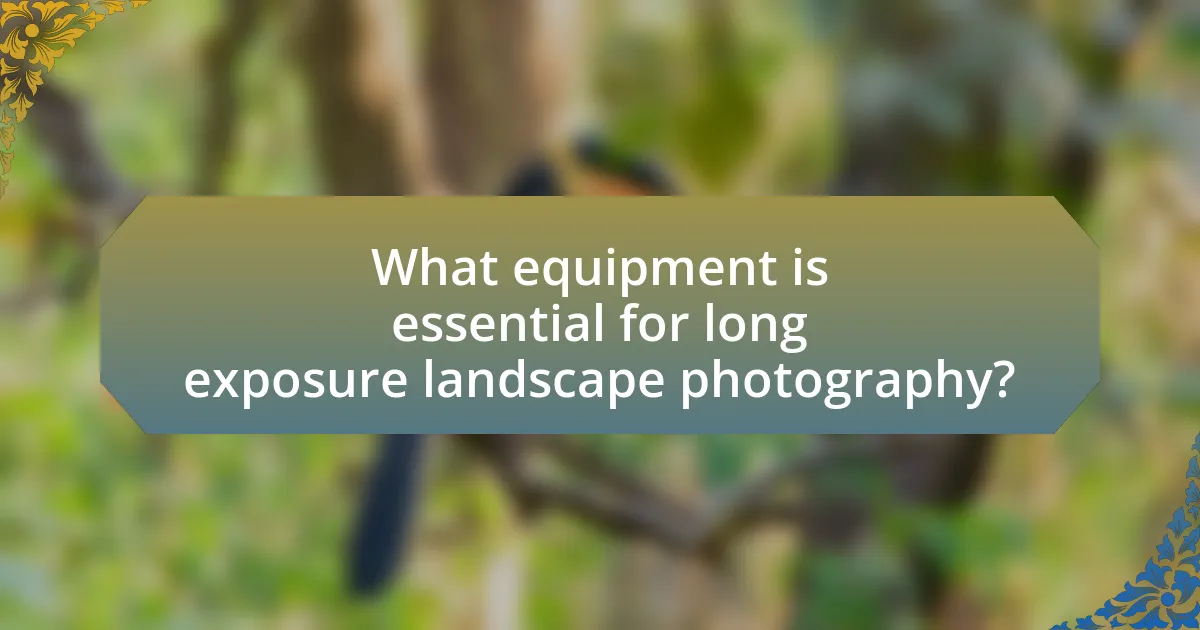
What equipment is essential for long exposure landscape photography?
Essential equipment for long exposure landscape photography includes a sturdy tripod, a camera with manual settings, and neutral density filters. A sturdy tripod stabilizes the camera during extended exposure times, preventing any movement that could blur the image. A camera with manual settings allows photographers to adjust shutter speed, aperture, and ISO, which are crucial for achieving the desired exposure. Neutral density filters reduce the amount of light entering the lens, enabling longer exposure times without overexposing the image. These components are fundamental for capturing sharp, well-exposed long exposure photographs in landscape settings.
What types of cameras are best suited for long exposure photography?
DSLR and mirrorless cameras are best suited for long exposure photography due to their ability to manually control settings such as shutter speed, aperture, and ISO. These cameras typically feature larger sensors that capture more light, which is essential for achieving the desired effects in long exposure shots. Additionally, they often allow for the use of neutral density filters, which further extend exposure times without overexposing the image. The flexibility in lens choice and the availability of advanced features like bulb mode enhance their capability for capturing stunning long exposure images.
How do different camera settings affect long exposure results?
Different camera settings significantly influence long exposure results by altering exposure time, aperture, and ISO sensitivity. Longer exposure times capture more light, resulting in brighter images and motion blur, while shorter exposure times can freeze motion. The aperture setting controls the amount of light entering the camera; a wider aperture (lower f-stop number) allows more light, which can lead to overexposure in long exposures, while a narrower aperture (higher f-stop number) reduces light, enhancing depth of field but requiring longer exposure times to maintain brightness. ISO sensitivity affects the camera’s light sensitivity; a lower ISO reduces noise but requires longer exposure times, while a higher ISO can introduce noise but allows for shorter exposures. These interactions are critical for achieving the desired artistic effect in long exposure photography, as evidenced by the common practice of using a tripod to stabilize the camera during extended exposures, ensuring sharpness and clarity in the final image.
What role do lenses play in long exposure landscape photography?
Lenses play a crucial role in long exposure landscape photography by influencing image sharpness, depth of field, and light transmission. The choice of lens affects how light enters the camera, which is vital for capturing the extended exposure times that characterize this style. For instance, wide-angle lenses allow for greater depth of field, enabling more of the scene to be in focus, while high-quality lenses minimize optical distortions and aberrations, ensuring clarity in the final image. Additionally, using neutral density filters with lenses can help control the amount of light entering the camera, allowing photographers to achieve longer exposure times without overexposing the image. This combination of lens characteristics and filters is essential for effectively capturing the desired motion blur and smoothness in elements like water and clouds, which are hallmarks of long exposure photography.
What accessories are recommended for successful long exposure shots?
Tripods are essential accessories for successful long exposure shots, as they provide stability and prevent camera shake during extended exposure times. A sturdy tripod minimizes vibrations that can blur images, especially in low-light conditions where longer shutter speeds are necessary. Additionally, neutral density (ND) filters are recommended, as they reduce the amount of light entering the lens, allowing for longer exposures without overexposing the image. Remote shutter releases are also beneficial, as they enable photographers to take shots without physically touching the camera, further reducing the risk of camera movement. These accessories collectively enhance the quality and effectiveness of long exposure photography.
How does a tripod contribute to the effectiveness of long exposure photography?
A tripod significantly enhances the effectiveness of long exposure photography by providing stability to the camera during extended shutter speeds. This stability prevents camera shake, which can lead to blurred images, especially when exposures last several seconds or longer. Research indicates that even slight movements can compromise image clarity, making a sturdy tripod essential for capturing sharp, detailed photographs in low-light conditions or when using slow shutter speeds.
What filters are beneficial for long exposure landscape photography?
Neutral density (ND) filters are beneficial for long exposure landscape photography as they reduce the amount of light entering the lens, allowing for longer exposure times without overexposing the image. Specifically, ND filters come in various strengths, such as 3-stop, 6-stop, and 10-stop, which enable photographers to achieve effects like smooth water surfaces or motion blur in clouds. The effectiveness of ND filters is supported by their ability to maintain image quality while extending exposure times, making them essential tools for capturing dynamic landscapes under bright conditions.
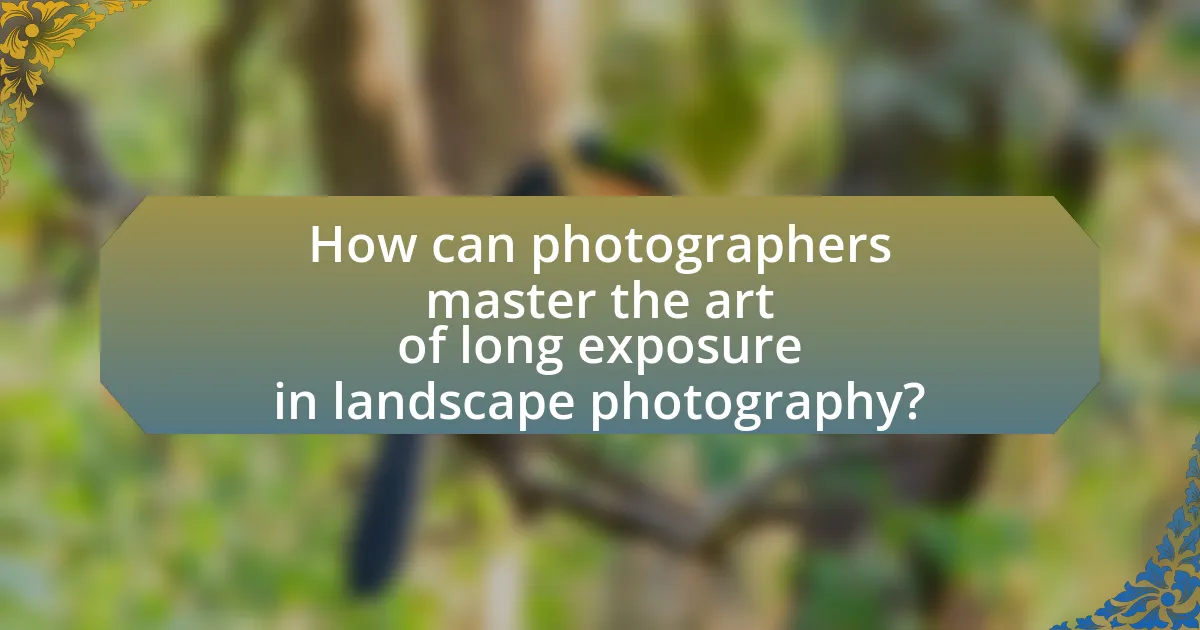
How can photographers master the art of long exposure in landscape photography?
Photographers can master the art of long exposure in landscape photography by utilizing a sturdy tripod, selecting appropriate shutter speeds, and employing neutral density filters. A sturdy tripod stabilizes the camera, preventing any movement during the extended exposure time, which can range from several seconds to minutes. Selecting the right shutter speed is crucial; slower speeds allow for the smooth capture of motion, such as flowing water or moving clouds, enhancing the ethereal quality of the image. Neutral density filters reduce the amount of light entering the lens, enabling longer exposures even in bright conditions, which is essential for achieving the desired effects without overexposing the image. These techniques are widely recognized in photography literature, emphasizing their effectiveness in creating stunning long exposure landscapes.
What techniques can improve long exposure photography skills?
To improve long exposure photography skills, photographers should utilize techniques such as using a sturdy tripod, employing neutral density filters, and mastering the exposure triangle. A sturdy tripod stabilizes the camera, preventing unwanted movement during long exposures, which can last from several seconds to minutes. Neutral density filters reduce the amount of light entering the lens, allowing for longer shutter speeds without overexposing the image. Mastering the exposure triangle—shutter speed, aperture, and ISO—enables photographers to balance light and achieve the desired effects, such as smooth water or light trails. These techniques are essential for capturing high-quality long exposure images in landscape photography.
How can timing and lighting conditions affect long exposure outcomes?
Timing and lighting conditions significantly influence long exposure outcomes by affecting the amount of light captured and the overall mood of the image. For instance, shooting during the golden hour, shortly after sunrise or before sunset, provides softer, warmer light that enhances colors and textures, resulting in more visually appealing photographs. Conversely, shooting in harsh midday light can lead to overexposure and loss of detail, particularly in bright areas.
Additionally, the duration of the exposure impacts how motion is rendered; longer exposures can create smooth, ethereal effects in water or clouds, while shorter exposures may capture more defined shapes. The use of neutral density filters can also help manage light levels during bright conditions, allowing for longer exposures without overexposing the image. Thus, both timing and lighting are critical in achieving desired artistic effects in long exposure photography.
What are the best practices for composing long exposure landscape shots?
The best practices for composing long exposure landscape shots include selecting a strong foreground element, using leading lines to guide the viewer’s eye, and ensuring a balanced composition. A strong foreground element adds depth and interest, while leading lines, such as roads or rivers, create a natural flow within the image. A balanced composition can be achieved by following the rule of thirds, placing key elements along the grid lines or intersections. Additionally, using a tripod is essential to maintain stability during long exposure, preventing camera shake and ensuring sharpness. These practices enhance the overall impact of the photograph, making it visually compelling.
What common challenges do photographers face with long exposure photography?
Photographers face several common challenges with long exposure photography, including camera shake, light pollution, and exposure time management. Camera shake can occur due to the extended duration of exposure, leading to blurred images; using a sturdy tripod and remote shutter release can mitigate this issue. Light pollution, particularly in urban areas, can affect the quality of the image by introducing unwanted artificial light, which can be addressed by selecting locations with minimal light interference. Additionally, managing exposure time is crucial, as overexposure can wash out details; using neutral density filters can help control the amount of light entering the lens, allowing for longer exposures without losing detail.
How can photographers mitigate issues like camera shake and overexposure?
Photographers can mitigate issues like camera shake by using a tripod, which stabilizes the camera during long exposure shots. Additionally, employing image stabilization features, using a remote shutter release, or utilizing the camera’s timer function can further reduce the risk of shake. To address overexposure, photographers can adjust their aperture settings, use neutral density filters to limit light entering the lens, and ensure proper exposure settings by utilizing the camera’s histogram to monitor exposure levels. These methods are supported by the fact that tripods reduce movement, and neutral density filters effectively manage light, allowing for better control over exposure in varying lighting conditions.
What troubleshooting tips can help improve long exposure results?
To improve long exposure results, ensure stability by using a sturdy tripod to prevent camera shake. A stable base is crucial, as even minor movements can blur the image during extended exposure times. Additionally, utilize a remote shutter release or the camera’s timer function to avoid any vibrations caused by pressing the shutter button.
Another effective tip is to use neutral density filters, which reduce the amount of light entering the lens, allowing for longer exposures without overexposing the image. This technique is particularly beneficial in bright conditions, enabling smoother motion effects in water or clouds.
Lastly, check your camera settings, ensuring that the ISO is set to the lowest value to minimize noise, and use manual focus to avoid autofocus errors during the long exposure. These adjustments collectively enhance the clarity and quality of long exposure photographs.
What practical tips can enhance long exposure landscape photography?
To enhance long exposure landscape photography, use a sturdy tripod to eliminate camera shake during extended exposure times. A tripod stabilizes the camera, allowing for sharp images even with slow shutter speeds, which can range from several seconds to minutes. Additionally, utilize neutral density filters to reduce light entering the lens, enabling longer exposures in bright conditions without overexposing the image. This technique is essential for capturing smooth water surfaces or softening clouds, which are common goals in long exposure photography. Lastly, experiment with different exposure times to find the optimal balance between motion blur and detail retention, as varying the duration can significantly impact the final image’s aesthetic.
